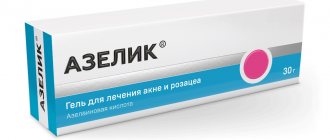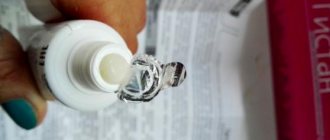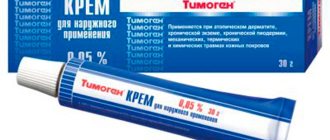Clindamycin ~ Antibiotic, lincosamide
The product is not available in the presented pharmacies*
A bacteriostatic antibiotic from the lincosamide group, has a broad spectrum of action, binds to the 50S subunit of the ribosomal membrane and inhibits protein synthesis in the microbial cell. Clindamycin may have a bactericidal effect against a number of gram-positive cocci. Active against Staphylococcus spp. (including Staphylococcus epidermidis, producing and non-producing penicillinase), Streptococcus spp. (excluding Enterococcus faecalis), Streptococcus pneumoniae, Corynebacterium diphtheriae, Mycoplasma spp., anaerobic and microaerophilic gram-positive cocci (including Peptococcus spp. and Peptostreptococcus spp.), Clostridium perfringens, Clostridium tetani, Bacteroides spp. (including Bacteroides fragilis and Prevotella melaninogenica), Fusobacterium spp., Propionibacterium spp., eubacterium and Actinomyces israelii. Most strains of Clostridium perfringens are sensitive to clindamycin, but other Clostridium spp. (including Clostridium sporogenes, Clostridium tertium) are resistant to its action, and therefore for infections caused by Clostridium spp., it is recommended to determine an antibiogram. Cross-resistance exists between clindamycin and lincomycin. More about the drug »
ATTENTION! ALWAYS check with your doctor or pharmacist to see if the found analogue can serve as a full replacement for the drug prescribed to you or the drug you are looking for. This is due to the need to use the dosage forms and doses prescribed specifically for you, which may differ even among analogues (more about analogues of drugs).
Pharmacodynamics and pharmacokinetics
the lincosamide antibiotic clindamycin as an active ingredient , is a local remedy used in gynecology for the treatment of gardnerellosis (vaginosis) of bacterial origin. The mechanism of action of local dosage forms of the drug (cream, suppositories) is aimed at disrupting the processes of intracellular protein synthesis in the microbial cell, which occurs at the level of the large ribosomal subunit 50S.
The spectrum of action of clindamycin is quite wide. In medium doses, the drug exhibits bacteriostatic effectiveness against many microorganisms . At higher dosages, clindamycin is characterized by a bactericidal effect aimed at destroying certain bacterial strains .
The main activity of clindamycin is observed against microorganisms leading to the formation of bacterial vaginosis , including: Mobiluncus spp. (mobiluncus), Gardnerella vaginalis (Gardnerella vaginalis), Bacteroides spp. (bacteroides), Peptostreptococcus spp. (peptostreptococci), Mycoplasma hominis (mycoplasma hominis).
Strains of Candida albicans ( thrush ) and Trichomonas vaginalis ( Trichomonas vaginalis insensitive to the effects of clindamycin .
Intravaginal (inside the vagina) single administration of clindamycin at a dose of 100 mg leads to systemic absorption of approximately 4% of the drug (about 4 mg). Plasma Cmax of clindamycin is 20 ng/ml.
Instructions:
Clinical and pharmacological group
23.007 (Antibiotic for topical use in gynecology)
Release form, composition and packaging
◊ Vaginal suppositories of white or white with a yellowish tint, cylindrical-conical shape; there are no inclusions on the longitudinal section; the presence of an airy and porous rod and a funnel-shaped recess is allowed.
| 1 sup. | |
| clindamycin (as phosphate) | 100 mg |
Excipients: semi-synthetic glycerides (such as “Estarinum”, “Vitepsol” or “Suppotsir”).
3 pcs. — cellular contour packages (1) — cardboard packs.
pharmachologic effect
An antibiotic from the lincosamide group, it has a wide spectrum of antimicrobial action. The mechanism of action is due to binding to the 50 S subunit of the ribosomal membrane and suppression of protein synthesis in the microbial cell. Acts bacteriostatically. A bactericidal effect is possible against a number of gram-positive cocci.
Active against Staphylococcus spp. (including Staphylococcus epidermidis, producing and non-producing penicillinase), Streptococcus spp. (excluding Enterococcus faecalis), Streptococcus pneumoniae, Corynebacterium diphtheriae, Mycoplasma spp., anaerobic and microaerophilic gram-positive cocci (including Peptococcus spp. and Peptostreptococcus spp.), Clostridium perfringens, Clostridium tetani, Bacteroides spp. (including Bacteroides fragilis and Prevotella melaninogenica), Fusobacterium spp., Propionibacterium spp., Eubacterium spp. and Actinomyces israelii.
Most strains of Clostridium perfringens are sensitive to clindamycin, but other Clostridium spp. (including Clostridium sporogenes, Clostridium tertium) are resistant to its action, and therefore for infections caused by Clostridium spp., it is recommended to determine an antibiogram.
Cross-resistance exists between clindamycin and lincomycin.
Pharmacokinetics
After a single intravaginal administration of clindamycin at a dose of 100 mg, 4% of the administered dose is subject to systemic absorption. Cmax in plasma - 20 ng/ml.
Dosage
Prescribe intravaginally 1 suppository 1 time/day immediately before bedtime, for 3-7 days in a row.
Before use, one suppository is released from the contour packaging, having previously cut the film along the contour of the suppository, and inserted, if possible, deep into the vagina, in a lying position.
Overdose
Due to the low absorption of the drug, an overdose is unlikely.
Drug interactions
Clindacin® enhances the effect of drugs rifampicin, aminoglycosides - streptomycin, gentamicin.
Enhances muscle relaxation caused by n-cholinergic blockers.
Clindacin® is incompatible with erythromycin, ampicillin, diphenylhydantoin derivatives, barbiturates, aminophylline, calcium gluconate and magnesium sulfate.
Use during pregnancy and lactation
Intravaginal use of Clindacin during pregnancy is possible only if the expected benefit to the mother outweighs the potential risk to the fetus. Clindamycin penetrates the placental barrier into the fetal circulatory system.
Clindamycin is excreted in breast milk. It is recommended to prescribe the drug with caution during lactation. Breastfeeding should be stopped during treatment.
Side effects
From the reproductive system: cervicitis, vaginitis, vulvovaginal irritation.
From the hematopoietic organs: rarely - reversible leukopenia, neutropenia, eosinophilia, agranulocytosis, thrombocytopenia.
Allergic reactions: maculopapular rash, urticaria, itching.
Other: with systemic absorption, other systemic side effects are possible, incl. in rare cases - pseudomembranous enterocolitis.
Storage conditions and periods
The drug should be stored out of the reach of children, in a dry place, protected from light at a temperature of 15° to 25°C. Shelf life: 3 years.
Indications
- bacterial vaginosis caused by microorganisms sensitive to the drug.
Contraindications
— I trimester of pregnancy;
- hypersensitivity to the components of the drug.
special instructions
Vaginal suppositories are not recommended for use simultaneously with other intravaginal medications.
Impact on the ability to drive vehicles and operate machinery
The drug does not affect the ability to concentrate and the speed of psychomotor reactions.
Conditions for dispensing from pharmacies
The drug is approved for use as a means of OTC.
Side effects
Some patients, when using Clindacin, experienced the development of negative side effects, including: a feeling of itching in the vagina , the formation of a maculopapular rash , the occurrence of urticaria , the development of cervicitis or colpitis (vaginitis), vulvovaginal irritation burning sensation .
In rare cases, the following were observed from the hematopoietic system: thrombocytopenia , reversible leukopenia , eosinophilia , neutropenia , agranulocytosis .
In case of significant systemic absorption of clindamycin, its inherent systemic side effects may occur, including the formation of pseudomembranous enterocolitis (very rare).
Instructions for use of Clindacin (Method and dosage)
Clindacin cream, instructions for use
Clindacin cream is intended for intravaginal use using a special disposable applicator included in the package with the medicinal product. The recommended single daily dosage of the cream is 100 mg of clindamycin (the volume of a completely filled applicator). It is best to administer the drug in the evening (before bedtime). The duration of the treatment course, as a rule, takes from 3 to 7 days.
Using the applicator
For proper dosing and introduction of the cream into the vagina, it is recommended to use disposable applicators contained in the package with the drug and adhere to the technique for their use, namely:
- remove the protective cap from the tube of cream;
- screw a disposable plastic applicator into its place;
- squeeze the opposite end of the tube to completely fill the applicator (the applicator is considered completely filled when its independently moving piston reaches the stop);
- lying on your back, insert the applicator into the vagina as deeply as possible;
- Gently press the applicator piston until it is completely empty;
- Carefully remove the used applicator from the vagina and throw it away.
Clindacin suppositories, instructions for use
Clindacin suppositories are also used intravaginally, with a single daily administration of 1 suppository, preferably in the evening (before bedtime). The duration of the treatment course, as a rule, takes from 3 to 7 days.
For proper use of the drug, one suppository should be released from the outer contour packaging by cutting the protective film along the contours of the suppository. Then, in a lying position, insert the suppository into the vagina as deeply as possible.
Description of the drug
Clindacin B prolong is a thick white cream with a slightly yellowish tint and does not have a specific odor. After insertion into the vagina, its previously dense consistency becomes jelly-like. As a result, a film with active ingredients is formed on the surface of the mucous membranes. They are released into pathological lesions gradually over 3 days. It is the long-term effect of the drug that explains the presence of the prefix “prolong” in its name. Why do gynecologists (and sometimes urologists) prescribe Clindacin B prolong cream to patients:
- reducing the severity of symptoms of bacterial or fungal vaginosis;
- inhibition of the growth and reproduction of pathogenic bacteria and fungi, and then their complete destruction;
- increasing the number of lacto- and bifidobacteria in the vagina, restoring the optimal pH value;
- preventing the spread of pathogenic microorganisms to healthy areas of the mucous membranes.
The attending physician includes the drug in therapeutic regimens after diagnosing both acute and chronic vaginosis. Usually 7 days are enough to completely eliminate the cause and all symptoms of the disease.
The use of Clindamycin B prolong helps prevent the development of complications. Often, against the background of inhibition of pathogenic bacteria, yeast-like fungi begin to rapidly multiply. The antimycotic contained in the drug quickly suppresses their activity.
Clinical and pharmacological group
Clindacin B prolong is included in the clinical and pharmacological group of combined drugs for the treatment of vaginosis. It also refers to drugs with antimycotic and bacteriostatic effects for topical use.
pharmachologic effect
The therapeutic effect of Clindacin B prolong is due to the properties of its active ingredients. These are the antibiotic clindamycin and the antimycotic butoconazole. Unlike vaginitis, vaginosis develops with the activation of bacteria and fungi that constantly live in the vagina. With a decrease in immunity, these representatives of opportunistic microflora are activated.
The result of their reproduction is a decrease in the number of lactobacilli, which create an acidic environment. Dysbacteriosis develops, causing vaginal discharge, itching and pain. Even a single use of Clindacin B prolong improves the patient’s condition due to its diverse effects:
- butoconazole disrupts the synthesis of ergosterols, reducing the strength of fungal cells. Biologically active substances and water penetrate into them. Bacterial cells gradually dissolve and die;
- Clindamycin binds to ribosomal membrane subunits, interfering with the production of proteins. Bacteria lose their ability to reproduce and their numbers decrease. When the drug is used in high doses, it exhibits bactericidal rather than bacteriostatic activity.
The ingredients of the combined product inhibit Candida fungi, pathogens of mycosporia, epidermophytosis, and trichophytosis. They suppress the activity of Gardinella, some strains of clostridia, bacteroides, mycoplasmas, and peptostreptococci.
As the number of pathogenic microorganisms decreases, the number of lactobacilli in the vagina increases. The acidic environment is restored, regenerative and metabolic processes are accelerated, and unpleasant sensations disappear.
Release form and composition
Cream (gel, ointment) Clindacin B prolong is produced by a domestic pharmaceutical factory. The manufacturer packages the cream in aluminum tubes with a screw cap. Each of them is enclosed in a cardboard box along with instructions for use. The secondary packaging contains one applicator containing 6 g of cream. The 20 g tube comes with three attachments for easy intravaginal insertion.
The active ingredients of the drug are butoconazole and clindamycin. The auxiliary composition of the cream is represented by the following components:
- preservatives phenoxyethanol, ethylhexylglycerol;
- propylene glycol;
- isopropyl myristate;
- macrogol cetostearate;
- cetostearyl alcohol;
- hydroxypropyl distarch phosphate;
- sodium hydroxide;
- water.
Additional ingredients are needed not only to form a creamy base. They ensure optimal absorption of clindamycin and butoconazole into the vaginal mucosa. A protective layer is formed on their surface, restraining the spread of pathology to healthy connective tissue structures.
Storage conditions and periods
The shelf life of the combined product is 24 months. It should be stored at a temperature of 15°-25°C in places protected from direct sunlight. The drug is unsuitable for treatment after freezing. It loses its therapeutic properties if its consistency, color or smell changes. After opening the tube, Clindacin B should be used within 4-5 weeks. Access for small children to the place where the cream is stored should be limited.
Interaction
When used in combination with clindamycin, the effectiveness of aminoglycosides ( Streptomycin ), Rifampicin and Gentamicin .
Clindamycin is incompatible with Aminophylline , Erythromycin , Magnesium sulfate , Ampicillin , Calcium gluconate , diphenylhydantoin and barbiturates.
The effects of clindamycin increase muscle relaxation caused by the effects of n-cholinergic blockers .
special instructions
In case of prolonged use of the drug, the possibility of excessive growth of microorganisms insensitive to its active ingredient, especially fungal strains of Candida, is allowed.
The combined use of Clindacin with other intravaginal medications is not recommended.
Due to the minimal, but still systemic absorption of clindamycin (about 4%), against the background of its topical use, diarrhea , requiring discontinuation of the drug.
Pharmacokinetics
Suction
After intravaginal clindamycin administration of 100 mg/single dose for 7 days, the Cmax of clindamycin in the blood plasma is achieved after 10 hours (4-24 hours) and on the 1st day averages 18 ng/ml (4-47 ng/ml), and on the 7th day - 25 ng/ml (6-61 ng/ml), while systemic absorption is about 5% (0.6-11%) of the administered dose.
In women with bacterial vaginosis, with a similar dosing regimen, about 5% of clindamycin is subject to systemic absorption (with a smaller range of 2-8%), Cmax is achieved 14 hours (4-24 hours) after administration and averages 13 ng/ml on the first day (6-34 ng/ml), and on the 7th day - 16 ng/ml (7-26 ng/ml).
The systemic exposure of clindamycin when administered intravaginally is less pronounced than when administered orally or intravenously.
Removal
T1/2 is 1.5-2.6 hours. Practically does not accumulate.
Analogs
Level 4 ATC code matches:
Ecofucin
Primafungin
Nystatin
Polygynax Virgo
Polygynax
Analogs of Clindacin are represented by local medicinal drugs used in gynecology for the treatment of similar bacterial infections: Nystatin , Polygynax , Sintomycin , Pimafucin , Natamycin , Ecofucin .
The price of analogues of suppositories of this drug varies widely, for example, 10 suppositories of the drug Sintomycin can be bought for 40-60 rubles, and 12 vaginal capsules of Polygynax for 600-650 rubles.
During pregnancy and lactation
According to the official instructions, clinical studies of the safety of Clindacin during pregnancy in the first trimester have not been conducted, and therefore its use in this period is not recommended. Treatment of women with Clindacin in the second and third trimester of pregnancy is allowed only in cases where the benefits of such therapy for the mother significantly exceed the possible negative consequences for the fetus.
Despite this, in gynecology there is a practice of prescribing Clindacin in the second and third trimester of pregnancy , since some vaginal infections undoubtedly require such treatment. Considering reviews of this drug in the form of a cream, as well as reviews of suppositories during pregnancy during these periods, it is worth noting that in the vast majority of cases, therapy with Clindacin led to relief from the infectious disease without any negative consequences for the expectant mother and fetus.
The excretion of intravaginally used clindamycin in the milk of a nursing mother has not been studied, and therefore, its administration during lactation is possible only with a positive comparison of the benefits of such treatment for the mother in comparison with the possible risks for the newborn.
Indications for use
For systemic use: severe infectious and inflammatory diseases caused by microorganisms sensitive to clindamycin: pneumonia, lung abscess, pleural empyema, osteomyelitis, endometritis, adnexitis, purulent infections of the skin, soft tissues, wounds, peritonitis. Prevention of peritonitis and intra-abdominal abscesses after perforation or intestinal trauma (in combination with aminoglycosides). As a reserve antibiotic for infections caused by strains of staphylococcus and other gram-positive microorganisms resistant to penicillin. As a means of prevention during tooth extraction.
For external use: acne vulgaris.
For local use in gynecology (vaginal gel, suppositories): vaginosis caused by sensitive microorganisms.
Reviews about Clindacin
Most women who use this drug to treat bacterial vaginosis leave positive reviews about Clindacin suppositories, including patients forced to resort to this drug during pregnancy in the second and third trimester . Reviews about Clindacin cream are not so numerous, but they are also positive in terms of the effectiveness and safety of this medicinal drug. Summarizing the general impression of patients about Clindacin therapy for bacterial vaginosis , we can confidently recommend it for use according to indications, but only after consulting a specialist doctor.
Indications for use of the drug CLINDAMYCIN for systemic use
- infectious and inflammatory diseases caused by microorganisms sensitive to clindamycin;
- infections of the upper respiratory tract and infections of the ENT organs (pharyngitis, tonsillitis, sinusitis, otitis), lower respiratory tract (pneumonia, including aspiration, lung abscess, pleural empyema, bronchitis), scarlet fever, diphtheria;
- infections of the urogenital tract (chlamydia, endometritis, vaginal infections, tubo-ovarian inflammation);
- infections of the skin and soft tissues (infected wounds, abscesses, boils, panaritium), abdominal cavity (peritonitis, abscess), oral cavity;
- acute and chronic osteomyelitis;
- septicemia (primarily anaerobic);
- bacterial endocarditis;
- prevention of peritonitis and intra-abdominal abscesses after intestinal perforation or as a result of traumatic infection (in combination with aminoglycosides).
Clindacin price, where to buy
In comparison with its analogues for topical use (including vaginal ointments, creams, suppositories, capsules, etc.), the cost of Clindacin is at a high level. For example, the price of Clindacin in candles No. 3 is about 650 rubles (accordingly, 6 candles can be purchased on average for 1,300 rubles). The price of Clindacin cream varies between 350-400 rubles per 20 gram tube.
- Online pharmacies in RussiaRussia
ZdravCity
- Clindacin cream vaginal.
2% 20gAO Akrikhin RUR 439 order - Clindacin B Prolong cream vaginal. 2%+2% tube 20gAO Akrikhin
RUR 583 order
Clindacin
Active substance:
Clindamycin*
Pharmgroup:
Lincosamides
Average price in pharmacies
| Name | Manufacturer | average price |
| Clindacin 0.1 n3 supp vag | AKRIKHIN | 458.00 |
| Clindacin 2% 20.0 cream vag | AKRIKHIN | 374.00 |
| Clindacin b prolong 2%+2% 20.0 cream vag | AKRIKHIN | 463.00 |
Analogs for the active substance:Dalatsin Dalacin C phosphate Zerkalin Klimitsin Clindamycin Clindamycin phosphate Klindafer Clindes Klindovit | Application area:Bacterial vaginitis Bacterial vaginosis Bacterial vaginitis Bacterial vaginosis Vaginitis Bacterial vaginitis Inflammatory diseases of the vagina and vulva Inflammatory diseases of the female genitalia Inflammatory diseases of the female genital organs Vulvitis Vulvovaginal infections Vulvovaginitis Atrophic vulvovaginitis Bacterial vulvovaginitis Estrogen deficiency vulvovaginitis Vulvovaginitis Gardnerellosis Fungal vulvovaginitis in girls and virgins Fungal vulvovaginitis in girls and virgins Vaginal infection Genital infection Colpitis Violation of the purity of vaginal secretions Nonspecific cervicovaginitis Nonspecific vulvitis Nonspecific vulvovaginitis Nonspecific colpitis Recurrent nonspecific bacterial vaginosis Senile colpitis Mixed vaginal infection Mixed vaginitis Mixed vaginal infections Mixed colpitis Specific vulvovaginitis Chronic vaginitis Chronic recurrent mycosis of the vagina Cervicovaginitis |











